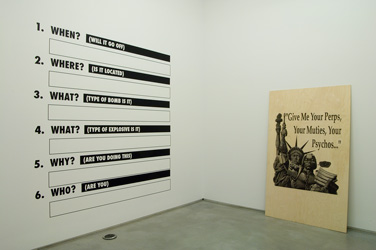Gardar Eide Einarsson, Judge, 2007
Born 1976 in Oslo, Norway; lives in New York, New York
Investigations into various forms of social transgression and arguments for political subversion, Gardar Eide Einarsson’s text-based works provoke the critical analysis associated with reading to augment the immediate visceral experience of viewing his art. To this end, his choice of media is determined by his current discourse on communities in relation to their outsiders. Visual imagery borrowed from underground subcultures including the criminal world and left-wing militias, portrayed in a primarily black-and-white palette, gives Einarsson’s work a stylish punk sheen that evokes rebellion through its cold, hard-edged rejection of sentiment. His installations often combine paintings leaned against walls as “props,” explicit messages printed on flags or illuminated on light boxes, images co-opted from graffitii, skateboarding graphics, or punk music flyers screenprinted or painted directly onto gallery walls, videos screened on televisions, photography, and sculpture such as austere furniture centered in the exhibition space.
Mining his understanding of how graphic design and advertising methods manipulate public beliefs, Einarsson appropriates logos, symbols, phrases, and slogans to recontextualize meaning, creating a tension between imagery and the action it compels the viewer to take. For his 2006 show Population One at Standard (Oslo), Einarsson referenced Russian prison tattoos, comic-book character Judge Dredd’s villainous narratives, and a confiscated forged driver’s license to consider the renegade value in aberrant society members’ ideologies. One wall panel shaped like a comic-book blurb quotes Dredd: “Odious though it was to turn myself into a tawdry attraction, I had greater goals to consider.” Hung beside it was a painting of two white triangles pointed together on a black background; though based on a prison tattoo, I’ll Never Give My Hand to the Police (2007) evades any obvious visual associations. Einarsson purposely problematizes his own work to avoid didactic, facile expressions of negativity or controversy. His use of text allows for a directness that both recalls and critiques artworks decrying political injustices made during the 1990s by artists like Barbara Kruger. By staging textual works alongside abstract objects, images, and props, Einarsson embeds his politics more deeply in his search for answers, and through Minimalist formalism he oΩers opaque or ambivalent translations of his skepticism toward established power structures.
In South of Heaven, a 2007 installation at Frankfurter Kunstverein, the artist again applied text to underscore ideas of authority and rebellion. What looks like ad hoc gra≈ti scrawled on one wall by an angry teenager declaring “You just don’t get it dad, so fuck off” is contextually inverted not only by a flag emblazoned with “American Liberty” hanging from the ceiling nearby but by the fact that the “gra≈ti” was premeditated, designed on a computer, then carefully placed on the wall as a formal painting. As a native Norwegian relocated to the United States, Einarsson creates work increasingly opposed to what can be seen as the hypocrisies of our current government by highlighting our national preoccupation with individual freedoms. TRINIE DALTON
Gardar Eide Einarsson, Judge, Installation view, Team Gallery, New York, 2007
























